Petrified wood
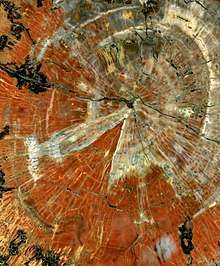
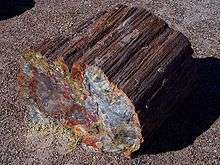

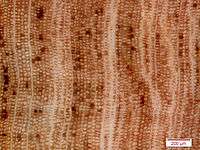
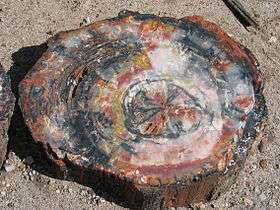
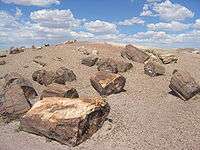
.jpg)
Petrified wood (from the Latin root petro meaning "rock" or "stone"; literally "wood turned into stone") is the name given to a special type of fossilized remains of terrestrial vegetation. It is the result of a tree or tree-like plants having completely transitioned to stone by the process of permineralization. All the organic materials have been replaced with minerals (mostly a silicate, such as quartz), while retaining the original structure of the stem tissue. Unlike other types of fossils which are typically impressions or compressions, petrified wood is a three-dimensional representation of the original organic material.
The petrifaction process occurs underground, when wood becomes buried under sediment or volcanic ash and is initially preserved due to a lack of oxygen which inhibits aerobic decomposition. Mineral-laden water flowing through the covering material deposits minerals in the plant's cells; as the plant's lignin and cellulose decay, a stone mold forms in its place. The organic matter needs to become petrified before it decomposes completely.[1] The process lasts millions of years.[2] A forest where such material has petrified becomes known as a petrified forest.
Elements
Elements such as manganese, iron, and copper in the water/mud during the petrification process give petrified wood a variety of color ranges. Pure quartz crystals are colorless, but when contaminants are added to the process the crystals take on a yellow, red, or another tint.
Following is a list of contaminating elements and related color hues:
- carbon – black
- chromium – green/blue
- cobalt – green/blue
- copper – green/blue
- iron oxides – red, brown, and yellow
- manganese – pink/orange
- manganese oxides – blackish/yellow
Petrified wood can preserve the original structure of the stem in all its detail, down to the microscopic level. Structures such as tree rings and the various tissues are often observed features.
Petrified wood is a fossil in which the organic remains have been replaced by minerals in the slow process of being replaced with stone. This petrification process generally results in a quartz chalcedony mineralization. Special rare conditions must be met in order for the fallen stem to be transformed into fossil wood or petrified wood. In general, the fallen plants get buried in an environment free of oxygen (anaerobic environment), which preserves the original plant structure and general appearance. The other conditions include a regular access to mineral rich water in contact with the tissues, replacing the organic plant structure with inorganic minerals. The end result is petrified wood, a plant, with its original basic structure in place, replaced by stone. Exotic minerals allow the red and green hues that can be seen in rarer specimens.
Locations
Areas with a large number of petrified trees include:
- Argentina – the Sarmiento Petrified Forest and Jaramillo Petrified Forest in Santa Cruz Province in the Argentine Patagonia have many trees that measure more than 3 m (10 ft) in diameter and 30 m (100 ft) long.[3]
- Australia – has deposits of petrified and opalised wood. Chinchilla, Queensland is famous for its 'Chinchilla Red'.
- Belgium – Geosite Goudberg near Hoegaarden.[4][5][6]
- Brazil:
- in the geopark of Paleorrota, there is a vast area with petrified trees.[7]
- Monumento Natural das Árvores Fossilizadas (Fossil Trees Natural Monument) in Tocantins: petrified forests of dicksoniaceae (specifically Psaronius and Tietea singularis) and arthropitys
- Petrified forests of dicksoniaceae (specifically Psaronius and Tietea singularis) and arthropitys can also be found in the state of São Paulo [8]
- Floresta Fóssil de Teresina near Rio Poti, Piauí, Permian (around 280-270 million years ago).
- Canada – in the badlands of southern Alberta; Petrified wood is the provincial stone of Alberta. Axel Heiberg Island in Nunavut has a large petrified forest. In and around the North Saskatchewan river, around the Edmonton area. Blanche Brook, in Stephenville, Newfoundland, has 305 million year old examples.[9]
- China – in the Junggar Basin of Xinjiang, northwest China government has issued a crackdown on collecting of this material, but large slabs and even large meeting tables have been made out of the colorful petrified wood.
- Czech Republic, Nová Paka – The most famous locality on Permian-Carboniferous rocks in the Czech Republic.
- Ecuador – Puyango Petrified Forest - One of the largest collections of petrified wood in the world.[10]
- Egypt – petrified forest in Cairo-Suez road, declared a national protectorate by the ministry of environment, also in the area of New Cairo at the Extension of Nasr city, El Qattamiyya, near El Maadi district, and Al Farafra oasis.[11]
- France – petrified forest in the village of Champclauson
- Georgia – Natural Monument of Goderdzi petrified forest.[12]
- Germany – the museum of natural history in Chemnitz has a collection of petrified trees, from the in situ Chemnitz Petrified Forest, found in the town since 1737.
- Greece – Petrified Forest of Lesvos, at the western tip of the island of Lesbos, is possibly the largest of the petrified forests, covering an area of over 150 km² and declared a National Monument in 1985. Large, upright trunks complete with root systems can be found, as well as trunks up to 22 m in length.
- India – protected geological sites known for petrified wood are the National Fossil Wood Park, Tiruvakkarai (20 million year old fossils) and the Akal Wood Fossil Park (180 million year old fossils). Petrified wood has also been discovered in Dholavira in Kutch, Gujarat, dating back to 187-176 million years.[13]
- Indonesia – petrified wood covers several area in Banten and also in some part of Mount Halimun Salak National Park.
- Israel – several examples of petrified wood occur in the HaMakhtesh HaGadol in the Negev desert.
- Italy:
- Foresta fossile di Dunarobba, petrified forest near Avigliano Umbro, Umbria (Central Italy), age Piacenzian.
- Foresta pietrificata di Zuri - Soddì, petrified forest near Soddì (Province of Oristano, Sardinia), age Chattian-Aquitanian.
- Libya – Great Sand Sea – Hundreds of square miles of petrified trunks, branches and other debris mixed with Stone Age artifacts
- Namibia – petrified forest of Damaraland
- New Zealand:
- Curio Bay on the Catlins coast contains many petrified wood examples.
- Fossil Forest, Takapuna, Auckland, New Zealand
- Saudi Arabia – petrified forest north of Riyadh
- Sudan - petrified forest north of El-Kurru
- Thailand – Bantak Petrified Forest Park in Ban Tak District[14]
- Ukraine – petrified araucaria trunks near Druzhkivka
- United Kingdom – many examples of petrified submerged forests can be found at low tide around the coast of England and Wales.[15]
- Fossil Grove, Glasgow, Scotland
- Fossil Forest, Dorset, England
- United States – petrified wood sites include:
- Petrified Wood Park in Lemmon, South Dakota
- Ginkgo/Wanapum State Park in Washington state
- Petrified Forest National Park in Arizona
- Petrified Forest (California) in California
- Mississippi Petrified Forest in Flora, Mississippi
- Florissant Fossil Beds National Monument near Florissant, Colorado
- Yellowstone Petrified Forest and Gallatin Petrified Forest, Yellowstone National Park, Wyoming
- The south unit of Theodore Roosevelt National Park outside Medora, North Dakota
- Gilboa Fossil Forest, New York
- Escalante Petrified Forest State Park in Utah
- Agate Desert in the Upper Rogue River Valley near Medford, Oregon
See also
- Amethyst Mountain
- Araucarioxylon arizonicum
- Fossil wood
- Jet (lignite)
- Palmoxylon (petrified palmwood)
- Submerged forest
- Wood opal
References
- ↑ "Frequently Asked Questions - Petrified Forest National Park (U.S. National Park Service)".
- ↑ "How Long Does it Take to Make Petrified Wood?". Live Science. Retrieved 6 February 2018.
- ↑ "Unieke collectie van versteend houten producten". xyleia.eu. Retrieved 2 November 2016.
- ↑ Jacob Leloux (May 25, 2001). "A petrified forest near Hoegaarden". Archived from the original on July 13, 2004.
- ↑ The in situ Glyptostroboxylon forest of Hoegaarden (Belgium) at the Initial Eocene Thermal Maximum (55 Ma)M. Fairon-Demaret, E. Steurbaut, F. Damblon, C. Dupuis, T. Smith, P. Gerrienne (2003). "The in situ Glyptostroboxylon forest of Hoegaarden (Belgium) at the Initial Eocene Thermal Maximum (55 Ma)" (PDF). Review of Palaeobotany and Palynology. 126 (126): 103–129. doi:10.1016/S0034-6667(03)00062-9.
- ↑ "Petrified Wood from Goudberg, Hoegaarden, Flemish Brabant Province, Belgium". Mindat.org. Hudson Institute of Mineralogy. Retrieved May 14, 2016.
- ↑ "RS VIRTUAL - O Rio Grande do Sul na Internet". Archived from the original on 2012-02-07.
- ↑ FAPESP Research Magazine - Edition 210 - August 2013
- ↑ Stephencille Heritage site
- ↑ Anon. "The Petrified Forest of Puyango". Viva travel guides. Viva. Retrieved 26 January 2010.
- ↑ "IAWA: The International Association of Wood Anatomists" (PDF).
- ↑ "Goderdzi Petrified Forest Natural Monument". Agency of Protected Areas of Georgia. Retrieved 11 September 2018.
- ↑ "Jurassic age plant fossil found near Dholavira". timesofindia.indiatimes.com/. The Times of India. Retrieved 7 July 2014.
- ↑ "THE PETRIFIED WOOD FOREST, TAK, THAILAND". 1 January 2012.
- ↑ Campbell, J.A.; Baxter M.S. (29 March 1979). "Radiocarbon measurements on submerged forest floating chronologies". Nature. Nature Publishing Group. 278 (5703): 409–413. doi:10.1038/278409a0. Retrieved 12 January 2010.
External links
| Wikimedia Commons has media related to Petrified wood. |